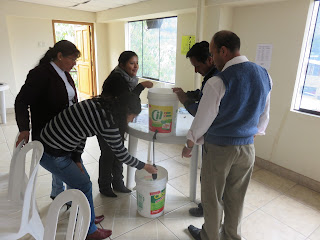A visiting group from the USA brought 5 Sawyer filters with them and can provide more if we think it's a good idea - so we hosted a workshop to try them out.
 |
| "To clean the filter, you force water through it THIS way..." |
I need to think about how the filtered water can be stored so that it stays clean!
To show visually how good the filter is, we dumped in a load of mud...
...and people were willing to drink the clear water that came out (the science says that invisible pathogens are also filtered out!)
Generally feedback was very positive because the filter is so small and light and easy and quick to install... some reservations about proper use and cleaning though!
 |
| Feedback time (I did a lot of listening as well as talking) |
I invited all the AIDIA staff as well as a big group from the local government water office - timing didn't quite work out as the government guys arrived just as we were finishing, so it turned into 2 workshops! Here's the second round...
Then at the weekend I went on a training course (organised by CAWST, whose community teaching materials I've been using for years, so I was excited to go and find out more about them) learning how to build Biosand filters and how they work in practice.
 |
| "rock paper scissors with a twist... the Pathogen destroys the Baby, the Baby, destroys the Filter (by blocking the pipe with a pebble, for example), and the Filter destroys the Pathogen. |
It was great to take part in a practical course with other people who work in the type of programme that I want to build. It was fun that so much of it was hands-on, but also good to go through lots of information about household-level water treatment (as opposed to community-level which is what most systems are in Apurímac) so that I can now consider both types of filters and compare them to the needs and the culture.
 |
| Sieving sand and gravel - we did lots of this when I worked in Ecuador so I felt right at home. |
 |
| We built 2 concrete filter casings... |
 |
| ...and learned about the PVC option the NGO "Desea PERU" had developed. |
Then it was time to clean all the sand and gravel that we had previously sieved... but not too much!
 |
| Explaining just how clean the sand should be! |
 |
| It took a LOT of water. |
 |
| The class... I really need to learn to stand at the back in photos. Here's my trademark slouch. |
The course was in Pisac so this meant four days in the Sacred Valley, near Cusco - such a hardship!
 |
| I stayed at this hotel in Cusco for the first time 15 years ago... and here's why I keep going back. |
On the final day we finished at lunchtime, so I got to visit the beautiful Archaeological Park of Pisac, and enjoy some walking.

























No comments:
Post a Comment